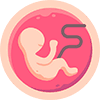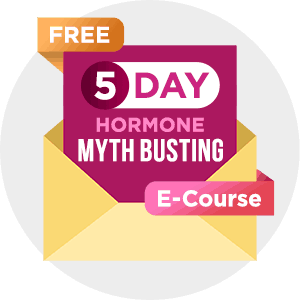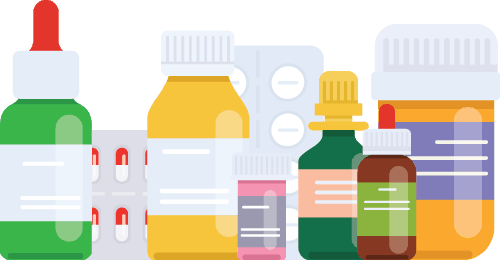Soares CN, Almeida OP, Joffe H, et al. Efficacy of estradiol for the treatment of depressive disorders in perimenopausal women: a double-blind, randomized, placebo-controlled trial. Arch Gen Psychiatry 2001;58:529-34.
Schmidt PJ, Nieman L, Danaceau MA, et al. Estrogen replacement in perimenopause-related depression: a preliminary report. Am J Obstet Gynecol 2000;183:414-20.
Kugaya A, Epperson CN, Zoghbi S, et al. Increase in prefrontal cortex serotonin 2A receptors following estrogen treatment in postmenopausal women. Am J Psychiatry 2003;160:1522-4.
Kaura V, Ingram CD, Gartside SE, et al. The progesterone metabolite allopregnanolone potentiates GABA(A) receptor-mediated inhibition of 5-HT neuronal activity. Eur Neuropsychopharmacol 2007;17:108-15.
Rapkin AJ, Morgan M, Goldman L, et al. Progesterone metabolite allopregnanolone in women with premenstrual syndrome. Obstet Gynecol 1997;90:709-14.
Shifren JL, Braunstein GD, Simon JA, et al. Transdermal testosterone treatment in women with impaired sexual function after oophorectomy. N Engl J Med 2000;343:682-8.
Weber B, Lewicka S, Deuschle M, et al. Testosterone, androstenedione and dihydrotestosterone concentrations are elevated in female patients with major depression. Psychoneuroendocrinology 2000;25:765-71.
Morrison JH, Brinton RD, Schmidt PJ, et al. Estrogen, menopause, and the aging brain: how basic neuroscience can inform hormone therapy in women. J Neurosci 2006;26:10332-48.
Brandes JL. The influence of estrogen on migraine: a systematic review. JAMA 2006;295:1824-30.
Bromberger JT, Kravitz HM. Mood and menopause: findings from the Study of Women's Health Across the Nation (SWAN) over 10 years. Obstetrics and gynecology clinics of North America. 2011;38(3):609-25.
Appa AA, Creasman J, Brown JS, Van Den Eeden SK, Thom DH, Subak LL, et al. The impact of multimorbidity on sexual function in middle-aged and older women: beyond the single disease perspective. J Sex Med. 2014 Nov;11(11):2744-55.
Maki PM, Gast MJ, Vieweg AJ, Burriss SW, Yaffe K. Hormone therapy in menopausal women with cognitive complaints: a randomized, double-blind trial. Neurology. 2007 Sep 25;69(13):1322-30.
Davison SL, Bell R, Donath S, Montalto JG, Davis SR. Androgen levels in adult females: changes with age, menopause, and oophorectomy. J Clin Endocrinol Metab. 2005;90(7):3847-53.
Santoro N, Torrens J, Crawford S, Allsworth JE, Finkelstein JS, Gold EB, et al. Correlates of circulating androgens in mid-life women: the study of women's health across the nation. J Clin Endocrinol Metab. 2005;90(8):4836-45.
Ameratunga D, Goldin J, Hickey M. Sleep disturbance in menopause. Internal Medicine Journal. 2012;2(7):742-7.
Polo-Kantola P. Sleep problems in midlife and beyond. Maturitas. 2011;68(3):224-32.
Erkkola R, Holma P, Jarvi T, Nummi S, Punnonen R, Raudaskoski T, et al. Transdermal oestrogen replacement therapy in a Finnish population. Maturitas. 1991;13(4):275-81.
Eichling PS, Sahni J. Menopause related sleep disorders. Journal of clinical sleep medicine : JCSM : official publication of the American Academy of Sleep Medicine. 2005;1(3):291-300.
NAMS Hormone Therapy Position Statement Advisory Panel. The 2017 hormone therapy position statement of The North American Menopause Society. Menopause. 2017;24(7):728-53.
Davis SR, Castelo-Branco C, Chedraui P, Lumsden MA, Nappi RE, Shah D, et al. Understanding weight gain at menopause. Climacteric. 2012;15(5):419-29.
Leeners B, Geary N, Tobler PN, Asarian L. Ovarian hormones and obesity. Hum Reprod Update. 2017;23(3):300-21.
Nowson CA, McGrath JJ, Ebeling PR, Haikerwal A, Daly RM, Sanders KM, et al. Vitamin D and health in adults in Australia and New Zealand: a position statement. Med J Aust. 2012;196(11):686-7.
Blume-Peytavi U, Atkin S, Gieler U, Grimalt R. Skin academy: hair, skin, hormones and menopause – current status/knowledge on the management of hair disorders in menopausal women. . Eur J Dermatol. 2012;22:310-8.
Welton AJ, Vickers MR, Kim J, Ford D, Lawton BA, MacLennan AH, et al. Health related quality of life after combined hormone replacement therapy: randomised controlled trial. BMJ. 2008;337:a1190.
Ma, J. & Xiao, L. Obesity and depression in US women: results from the 2005–2006 National Health and Nutritional Examination Survey. Obesity 18, 347–353 (2010).
Berk, M. et al. So depression is an inflammatory disease, but where does the inflammation come from? BMC Med. 11, 200 (2013).
Jovanovic, H. et al. Effects of estrogen and testosterone treatment on serotonin transporter binding in the brain of surgically postmenopausal women—a PET study. Neuroimage 106, 47–54 (2015).
McHenry, J., Carrier, N., Hull, E. & Kabbaj, M. Sex differences in anxiety and depression: role of testosterone. Front. Neuroendocrinol. 35, 42–57 (2014).
Lokuge, S., Frey, B. N., Foster, J. A., Soares, C. N. & Steiner, M. Depression in women: windows of vulnerability and new insights into the link between estrogen and serotonin. J. Clin. Psychiatry 72, e1563–e1569 (2011).
Young, E. A., Midgley, A. R., Carlson, N. E. & Brown, M. B. Alteration in the hypothalamic-pituitary-ovarian axis in depressed women. Arch. Gen. Psychiatry 57, 1157–1162 (2000).
Bastos, C. P. et al. Object recognition memory deficit and depressive-like behavior caused by chronic ovariectomy can be transitorialy recovered by the acute activation of hippocampal estrogen receptors. Psychoneuroendocrinology 57, 14–25 (2015).
Weber, B., Lewicka, S., Deuschle, M., Colla, M. & Heuser, I. Testosterone, androstenedione and dihydrotestosterone concentrations are elevated in female patients with major depression. Psychoneuroendocrinology 25, 765–771 (2000).
Giltay, E. J. et al. Salivary testosterone: associations with depression, anxiety disorders, and antidepressant use in a large cohort study. J. Psychosom. Res. 72, 205–213 (2012).
Hollinrake, E., Abreu, A., Maifeld, M., Van Voorhis, B. J. & Dokras, A. Increased risk of depressive disorders in women with polycystic ovary syndrome. Fertil. Steril. 87, 1369–1376 (2007).
Taponen, S. et al. Hormonal profile of women with self-reported symptoms of oligomenorrhea and/or hirsutism: Northern Finland birth cohort 1966 study. J. Clin. Endocrinol. Metab. 88, 141–147 (2003).
Zumoff, B. & Strain, G. W. A perspective on the hormonal abnormalities of obesity: are they cause or effect? Obes. Res. 2, 56–67 (1994).
Weiner, C. L., Primeau, M. & Ehrmann, D. A. Androgens and mood dysfunction in women: comparison of women with polycystic ovarian syndrome to healthy controls. Psychosom. Med. 66, 356–362 (2004).
Colangelo, L. A. et al. Association of sex hormones and sex hormone-binding globulin with depressive symptoms in postmenopausal women: the Multiethnic Study of Atherosclerosis. Menopause 19, 877–885 (2012).
Albert, P. R. Why is depression more prevalent in women? J. Psychiatry Neurosci. 40, 219 (2015).
Escobar-Morreale, H. F., Botella-Carretero, J. I., Alvarez-Blasco, F., Sancho, J. & San Millán, J. L. The polycystic ovary syndrome associated with morbid obesity may resolve after weight loss induced by bariatric surgery. J. Clin. Endocrinol. Metab. 90, 6364–6369 (2005).


























































 As a general rule this group does not accept the idea that Adrenal Fatigue as a condition and feel strongly that it's all a lot of hype and fuss over nothing.
As a general rule this group does not accept the idea that Adrenal Fatigue as a condition and feel strongly that it's all a lot of hype and fuss over nothing.
 Unfortunately, my symptoms didn’t improve, so when I went back she recommended we try a series of different herbal treatments. My sleep and mood improved, but not the energy or weight issues.
Unfortunately, my symptoms didn’t improve, so when I went back she recommended we try a series of different herbal treatments. My sleep and mood improved, but not the energy or weight issues.


